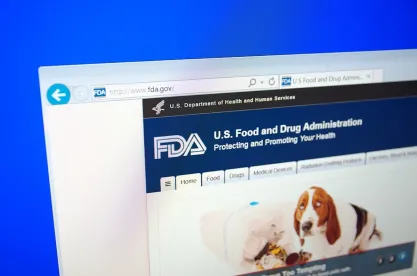On May 5, 2021, the U.S. Food and Drug Administration (FDA) issued a much-anticipated report, “Resiliency Roadmap for FDA Inspectional Oversight,” which provides a roadmap for the agency’s post-pandemic plans to return to a consistent state of inspection operations. For the near term, FDA reports that it will continue to prioritize critical inspections of both domestic and foreign facilities, including preapproval inspections for priority products and inspections in reaction to recalls or other safety issues. For the long term, the agency likely will employ the remote monitoring strategies it has implemented during the pandemic and expand its remote data collection capabilities to preserve resources and curb in-person inspections.
Looking Ahead and Finding a New-Normal
The FDA report sets forth FDA’s system of prioritization going forward, its plans to return to pre-pandemic operational level of inspection activities, and broad commitments to innovation.
Continued Reliance on Prioritization. FDA will continue to use a risk-based prioritization strategy in order to allocate its limited resources and ensure workforce safety going forward. FDA supplied a detailed look into its system of prioritization by regulated product in the following table:

* Inspection frequency is mandated by statute
A Commitment to Stay Agile. As evidence of its successful shift to remote monitoring activities, FDA cited over 1,300 record requests to human and animal drug and biologic manufacturers during the past year and that were crucial to making on-time regulatory decisions.
A Transition Plan. FDA set forth three plans to transition to pre-pandemic levels of inspectional activities based on the general trajectory of the pandemic, contemplating base-, best-, and worse-case scenarios:
-
Base-case scenario: FDA would continue using the COVID-19 Advisory Level (a data analytic tool used to assess the number of COVID-19 cases in a local area based on state and national data) to focus on mission-critical and prioritized domestic inspections until July 2021. Then, from July 2021 through September 2021 (the end of its fiscal year), FDA would resume standard operations by eliminating travel or establishment access restrictions and suspending use of the COVID-19 Advisory Level.
-
Best-scenario: FDA would return to standard operations in May 2021. This scenario, however, makes significant, and likely unrealistic, assumptions that travel restrictions are lifted in all states and countries, that FDA can plan trips quickly across the U.S. and within foreign countries, and there are no other emergency delays of prioritized work.
-
Worst-case scenario: If new variants emerge, or new COVID-19 challenges arise that pose significant risk to staff, FDA would continue to rely on the COVID-19 Advisory Level to make risk-based decisions, prioritize mission critical inspections, and continue to use remote-monitoring strategies.
However, note that, in all scenarios FDA estimated that foreign surveillance inspections conducted by inspectors traveling from the U.S. would not be achievable before September 2021. Until then, foreign inspections will continue to rely on FDA’s foreign offices.
Harnessing Data. Additionally, FDA also announced a years-long plan to invest in and modernize its data enterprise platforms and cross-program interoperability infrastructure to inform its regulatory oversight role and use of inspections.
FDA Inspections During the COVID-19 Pandemic
Mission Critical Inspections. At the outset of the pandemic, FDA paused all domestic and foreign routine surveillance facility inspections unless they were “mission-critical.” Mission critical inspections included pre-approval inspections for products that had received breakthrough therapy designation or regenerative medicine advanced therapy designation, products for serious conditions for which there is no other appropriate substitute, inspections relating to FDA’s COVID-19 response (e.g., drug shortages), and inspections in response to recalls or serious adverse events. From March 2020 through March 2021, FDA conducted a total of 821 mission-critical inspections, including 29 in foreign countries.
Prioritized Domestic Inspections. In July 2020, FDA resumed “prioritized domestic inspections” using its COVID-19 Advisory Rating. To determine inspection priority, FDA considered whether the inspection was a follow-up to previous violations, required to support an otherwise straight-forward product approval decision, or otherwise considered high-risk under statutory inspection frequency mandates (previously reported on here). From March 2020 to March 2021, FDA conducted a total of 777 prioritized domestic inspections—mostly in the human food and human drug space.
Limited Foreign Inspections. During the pandemic, FDA’s foreign-strategy focused on mission-critical inspections. FDA cited the challenges inherent in planning foreign versus domestic work, including coordination with the U.S. Department of State training and clearance processes, as well as additional country-specific restrictions. However, FDA’s limited staff it its foreign offices were able to execute some inspections during the pandemic. For example, FDA’s China office conducted 23 surveillance and 8 for-cause compliance follow-up inspections between October 2020 and March 2021.
Other Adaptations. To conduct mission critical and prioritized inspections, FDA adapted its routine in-person procedures by providing records and information requests in advance or in lieu of certain in-person inspections, expanding its remote monitoring activities (as previously reported here), sharing information with foreign regulatory partners, and enhanced sampling and monitoring at the US border.
***
This article is not an unequivocal statement of the law, but instead represents our best interpretation of where things currently stand. This article does not address the potential impacts of the numerous other local, state and federal orders that have been issued in response to the COVID-19 pandemic, but which are not referenced in this article.




 />i
/>i

